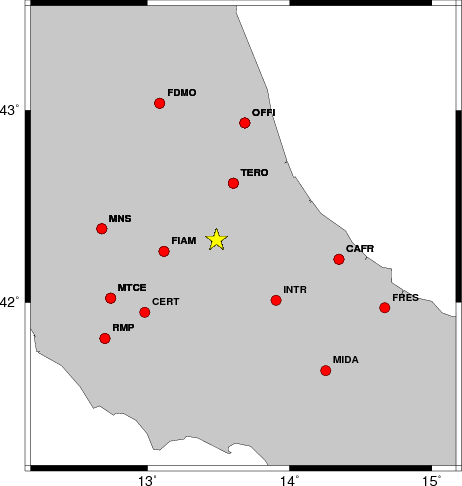
2009/04/07 22:43:42 42.328 13.486 9.3 3.00 Italy
USGS Felt map for this earthquake
USGS/SLU Moment Tensor Solution
ENS 2009/04/07 22:43:42:0 42.33 13.49 9.3 3.0 Italy
Stations used:
IV.CAFR IV.CERT IV.FDMO IV.FIAM IV.FRES IV.INTR IV.MIDA
IV.MNS IV.MTCE IV.OFFI IV.RMP IV.TERO
Filtering commands used:
hp c 0.02 n 3
lp c 0.10 n 3
Best Fitting Double Couple
Mo = 3.85e+20 dyne-cm
Mw = 2.99
Z = 0 km
Plane Strike Dip Rake
NP1 320 50 -90
NP2 140 40 -90
Principal Axes:
Axis Value Plunge Azimuth
T 3.85e+20 5 50
N 0.00e+00 -0 320
P -3.85e+20 85 230
Moment Tensor: (dyne-cm)
Component Value
Mxx 1.56e+20
Mxy 1.86e+20
Mxz 4.29e+19
Myy 2.22e+20
Myz 5.12e+19
Mzz -3.79e+20
##############
######################
#------#####################
#------------################
##-----------------############ T
###-------------------########## #
####---------------------#############
#####-----------------------############
#####------------------------###########
######-------------------------###########
#######----------- -----------##########
#######----------- P ------------#########
########---------- -------------########
########--------------------------######
#########-------------------------######
##########-----------------------#####
###########---------------------####
############-------------------###
#############----------------#
################-----------#
######################
##############
Global CMT Convention Moment Tensor:
R T P
-3.79e+20 4.29e+19 -5.12e+19
4.29e+19 1.56e+20 -1.86e+20
-5.12e+19 -1.86e+20 2.22e+20
Details of the solution is found at
http://www.eas.slu.edu/eqc/eqc_mt/MECH.IT/20090407224342/index.html
|
STK = 140
DIP = 40
RAKE = -90
MW = 2.99
HS = 0.5
The waveform inversion is preferred.
The following compares this source inversion to others
USGS/SLU Moment Tensor Solution
ENS 2009/04/07 22:43:42:0 42.33 13.49 9.3 3.0 Italy
Stations used:
IV.CAFR IV.CERT IV.FDMO IV.FIAM IV.FRES IV.INTR IV.MIDA
IV.MNS IV.MTCE IV.OFFI IV.RMP IV.TERO
Filtering commands used:
hp c 0.02 n 3
lp c 0.10 n 3
Best Fitting Double Couple
Mo = 3.85e+20 dyne-cm
Mw = 2.99
Z = 0 km
Plane Strike Dip Rake
NP1 320 50 -90
NP2 140 40 -90
Principal Axes:
Axis Value Plunge Azimuth
T 3.85e+20 5 50
N 0.00e+00 -0 320
P -3.85e+20 85 230
Moment Tensor: (dyne-cm)
Component Value
Mxx 1.56e+20
Mxy 1.86e+20
Mxz 4.29e+19
Myy 2.22e+20
Myz 5.12e+19
Mzz -3.79e+20
##############
######################
#------#####################
#------------################
##-----------------############ T
###-------------------########## #
####---------------------#############
#####-----------------------############
#####------------------------###########
######-------------------------###########
#######----------- -----------##########
#######----------- P ------------#########
########---------- -------------########
########--------------------------######
#########-------------------------######
##########-----------------------#####
###########---------------------####
############-------------------###
#############----------------#
################-----------#
######################
##############
Global CMT Convention Moment Tensor:
R T P
-3.79e+20 4.29e+19 -5.12e+19
4.29e+19 1.56e+20 -1.86e+20
-5.12e+19 -1.86e+20 2.22e+20
Details of the solution is found at
http://www.eas.slu.edu/eqc/eqc_mt/MECH.IT/20090407224342/index.html
|
The focal mechanism was determined using broadband seismic waveforms. The location of the event and the and stations used for the waveform inversion are shown in the next figure.

|
|
|
The program wvfgrd96 was used with good traces observed at short distance to determine the focal mechanism, depth and seismic moment. This technique requires a high quality signal and well determined velocity model for the Green functions. To the extent that these are the quality data, this type of mechanism should be preferred over the radiation pattern technique which requires the separate step of defining the pressure and tension quadrants and the correct strike.
The observed and predicted traces are filtered using the following gsac commands:
hp c 0.02 n 3 lp c 0.10 n 3The results of this grid search from 0.5 to 19 km depth are as follow:
DEPTH STK DIP RAKE MW FIT
WVFGRD96 0.5 140 40 -90 2.99 0.5343
WVFGRD96 1.0 320 50 -90 3.04 0.5286
WVFGRD96 2.0 140 35 -90 3.11 0.4880
WVFGRD96 3.0 170 45 -40 3.07 0.3792
WVFGRD96 4.0 170 85 -50 3.05 0.3673
WVFGRD96 5.0 160 75 -70 3.16 0.3920
WVFGRD96 6.0 165 75 -65 3.15 0.3958
WVFGRD96 7.0 170 80 -60 3.16 0.3975
WVFGRD96 8.0 15 65 35 3.15 0.4050
WVFGRD96 9.0 20 60 35 3.17 0.4048
WVFGRD96 10.0 20 60 35 3.18 0.4032
WVFGRD96 11.0 20 60 35 3.19 0.4011
WVFGRD96 12.0 20 60 40 3.20 0.3990
WVFGRD96 13.0 25 55 45 3.22 0.3974
WVFGRD96 14.0 25 55 45 3.23 0.3978
WVFGRD96 15.0 30 50 55 3.26 0.3886
WVFGRD96 16.0 30 50 55 3.27 0.3856
WVFGRD96 17.0 30 50 55 3.28 0.3806
WVFGRD96 18.0 40 45 65 3.30 0.3758
WVFGRD96 19.0 40 45 65 3.30 0.3693
WVFGRD96 20.0 315 50 85 3.28 0.3625
WVFGRD96 21.0 315 50 85 3.29 0.3572
WVFGRD96 22.0 315 50 85 3.30 0.3485
WVFGRD96 23.0 215 45 65 3.32 0.3456
WVFGRD96 24.0 210 45 55 3.33 0.3444
WVFGRD96 25.0 215 45 60 3.34 0.3415
WVFGRD96 26.0 210 50 55 3.34 0.3365
WVFGRD96 27.0 215 45 55 3.35 0.3300
WVFGRD96 28.0 215 45 55 3.35 0.3235
WVFGRD96 29.0 135 70 60 3.37 0.3231
The best solution is
WVFGRD96 0.5 140 40 -90 2.99 0.5343
The mechanism correspond to the best fit is
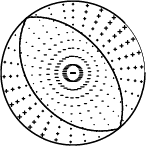
|
|
|
The best fit as a function of depth is given in the following figure:
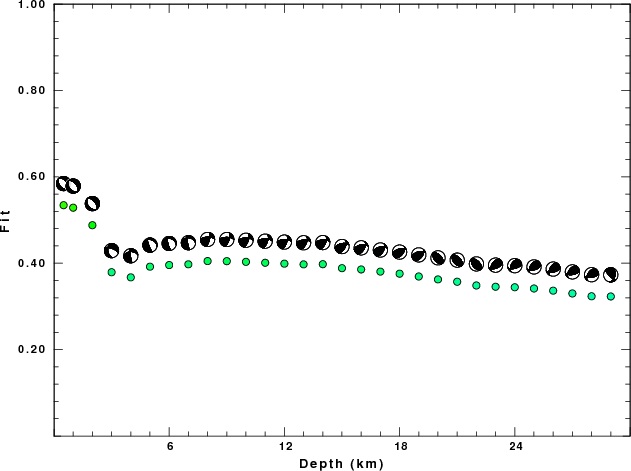
|
|
|
The comparison of the observed and predicted waveforms is given in the next figure. The red traces are the observed and the blue are the predicted. Each observed-predicted component is plotted to the same scale and peak amplitudes are indicated by the numbers to the left of each trace. The number in black at the rightr of each predicted traces it the time shift required for maximum correlation between the observed and predicted traces. This time shift is required because the synthetics are not computed at exactly the same distance as the observed and because the velocity model used in the predictions may not be perfect. A positive time shift indicates that the prediction is too fast and should be delayed to match the observed trace (shift to the right in this figure). A negative value indicates that the prediction is too slow. The bandpass filter used in the processing and for the display was
hp c 0.02 n 3 lp c 0.10 n 3
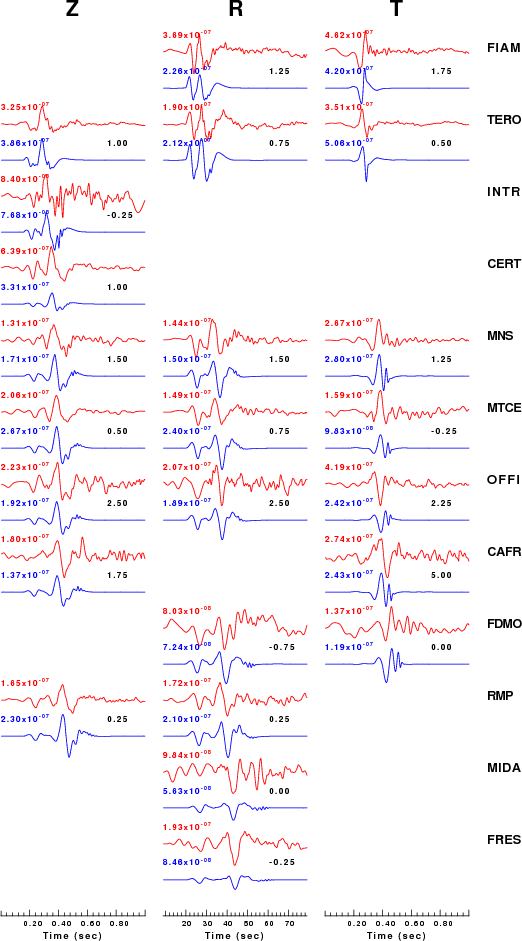
|
|
|
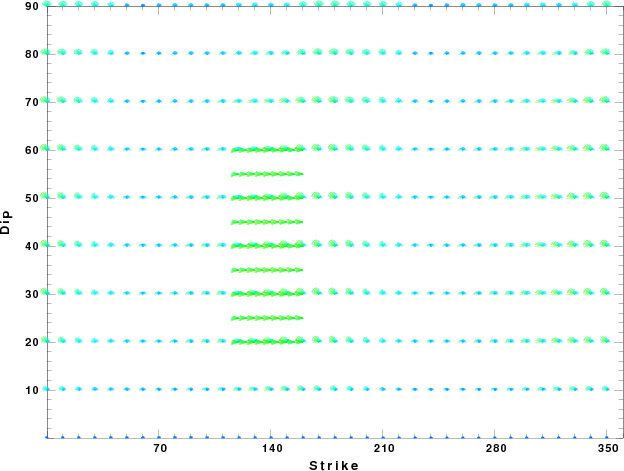
|
| Focal mechanism sensitivity at the preferred depth. The red color indicates a very good fit to thewavefroms. Each solution is plotted as a vector at a given value of strike and dip with the angle of the vector representing the rake angle, measured, with respect to the upward vertical (N) in the figure. |
The nnCIA used for the waveform synthetic seismograms and for the surface wave eigenfunctions and dispersion is as follows:
MODEL.01
C.It. A. Di Luzio et al Earth Plan Lettrs 280 (2009) 1-12 Fig 5. 7-8 MODEL/SURF3
ISOTROPIC
KGS
FLAT EARTH
1-D
CONSTANT VELOCITY
LINE08
LINE09
LINE10
LINE11
H(KM) VP(KM/S) VS(KM/S) RHO(GM/CC) QP QS ETAP ETAS FREFP FREFS
1.5000 3.7497 2.1436 2.2753 0.500E-02 0.100E-01 0.00 0.00 1.00 1.00
3.0000 4.9399 2.8210 2.4858 0.500E-02 0.100E-01 0.00 0.00 1.00 1.00
3.0000 6.0129 3.4336 2.7058 0.500E-02 0.100E-01 0.00 0.00 1.00 1.00
7.0000 5.5516 3.1475 2.6093 0.167E-02 0.333E-02 0.00 0.00 1.00 1.00
15.0000 5.8805 3.3583 2.6770 0.167E-02 0.333E-02 0.00 0.00 1.00 1.00
6.0000 7.1059 4.0081 3.0002 0.167E-02 0.333E-02 0.00 0.00 1.00 1.00
8.0000 7.1000 3.9864 3.0120 0.167E-02 0.333E-02 0.00 0.00 1.00 1.00
0.0000 7.9000 4.4036 3.2760 0.167E-02 0.333E-02 0.00 0.00 1.00 1.00
Here we tabulate the reasons for not using certain digital data sets
The following stations did not have a valid response files:
DATE=Fri May 1 14:49:43 CDT 2009